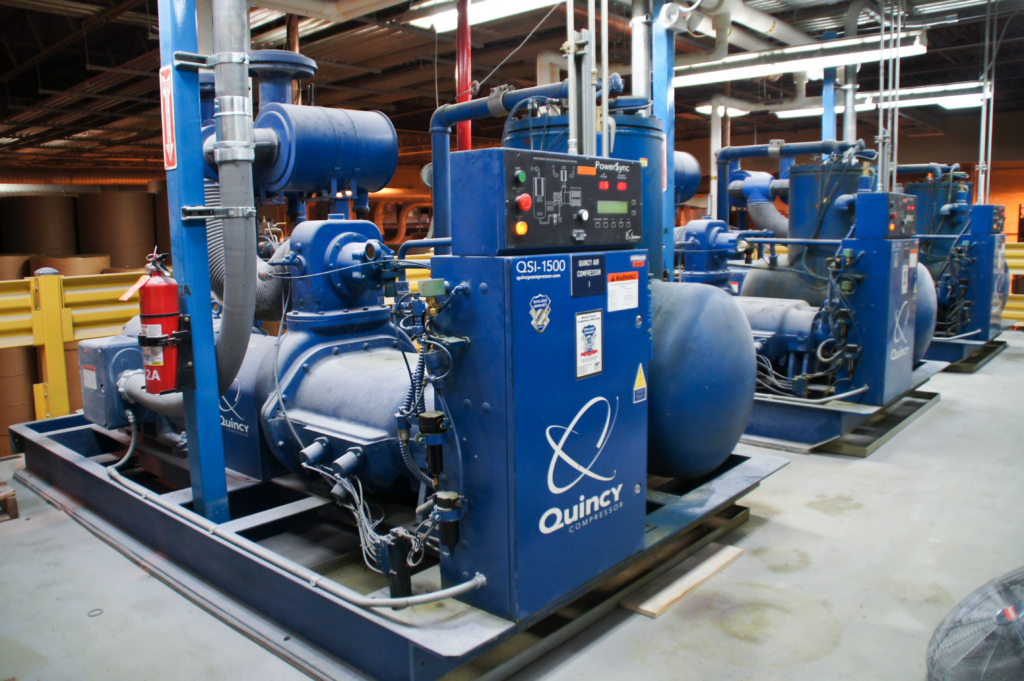How Does an Air Compressor Work?
In the manufacturing industry, air compressors convert ambient air into power that is used to drive pneumatic tools and automated equipment or directly in the production of products. Understanding how air compressors work is essential to their performance and efficiency, as well as to ensuring proper maintenance and high levels of reliability in your operation.
From Air Intake to Pressurized Power: How Do Air Compressors Work?

While each type of air compressor has a slightly different working principle, positive displacement air compressors operate by taking in ambient air, applying pressure in a compression chamber and then cooling the air before storage or use. Below, we will explain the core process.
| Step 1: Air Intake and Filtering | Ambient air is drawn into the compressor through an inlet valve. An intake filter is needed to remove contaminants, such as dirt, dust and moisture that may be present in the ambient air, preventing damage to compressor components. |
| Step 2: The Compression Process | Once air is drawn into the compressor, internal components, such as a piston or rotating screw, reduce the volume of the air by forcing the air into a smaller space, this is known as the compression chamber. The internal components of the compression chamber begin to reduce the volume of the air. As the air is compacted during this process, the pressure of the air increases. Common types of positive displacement air compressors, including reciprocating and rotary screw compressors, compress the air in different ways. |
| Step 3: Cooling, Storage and Discharge | Once design pressure is reached inside the compression chamber or chambers, the compressed air is discharged. Because the compression process generates air that is hot and moist, it will usually pass through an aftercooler with water separator before it enters the next stage or wet receiving tank. The compressed air is kept under pressure and stored in the receiving tank until it is needed. When there is demand, the air will be discharged from the storage tank regulated to a lower pressure, and travel through the air compression distribution system of pipes until it reaches the point of use where it powers pneumatic tools or equipment. |
Key Components of an Air Compression System
The air compressor is just one part of the air compression system.
The air compressor is just one part of the compressed air system which includes the following components:
- Air compressor: As discussed above, the air compressor is the heart of the system as it takes in ambient air, compresses it and stores the pressurized air.
- Wet Receiver Tank: This serves as storage for the compressed air until there is demand.
- Filters: Another essential component in a compressed air system, filters remove particulates such as dirt, dust, liquid water and oil from the air, preventing contaminants from creating blockages that decrease the efficiency and performance of the compressed air system and assuring compressed air quality requirements are met.
- Dryer: Common dryers used are refrigerated and regenerative. They remove remaining water vapor to meet compressed air dew point requirements.
- Dry air tank with regulator: While not every compressed air system requires a second dry air storage tank, if the demand for compressed air is fluctuating, an additional storage tank will ensure treated compressed air is readily available when needed and reduce wear & tear on the compressor and controls.
- Condensate traps: Moisture that is removed from the compressed air via the aftercooler, filters and air dryer must be removed from the system to avoid contamination and corrosion. Condensate traps and drains discharge the liquid water as it’s removed from the airstream.
How Your Compressor Knows When to Start and Stop
The pressure sensor, an important component of an air compressor, provides pressure regulation and tells the machine when to start and stop, load or unload, speed up or slow down, ensuring that the machine delivers the right amount of pressure, promoting energy efficient operation and preventing over-pressurization.
The simplest method of pressure regulation is a stop/start control function in which the controller sends a signal to the compressor’s motor, letting it know when to stop or start based on preset cut-in and cut-out pressure points. This is commonly used on reciprocating or small rotary screw compressors.
Basic Operation
- For small reciprocating compressors, be sure to read the owner’s manual thoroughly and follow the manufacturer’s instructions and requirements before attempting to start it.
- Thoroughly reading the owner’s manual prior to installation or attempting operation is a requirement for rotary screw type compressors also. Rotary screw compressors require an onsite startup service be performed by a factory authorized technician, which includes operational and maintenance training for factory maintenance personnel.
How to Tell if Your Compressor is Working Correctly
Air compressors are robust and reliable, but performing a few routine checks allows you to identify emerging issues before they result in downtime.
Routine checks should include:
Checking for leaks
Leaks in hoses and pipes should be identified and fixed ASAP, as leaks are the leading cause of excessive energy consumption and can lead to high electricity bills.
Inspecting filters and components
Be sure to regularly inspect compressor inlet filters and aftercoolers for clogs and blockages, which can decrease airflow and degrade performance and efficiency. Also check oil levels to ensure proper lubrication of moving parts. Look for cracks, leaks and wear in hoses and connections. Ensure that water separator condensate drains are functional. All of these are small, easily correctable items that prevent performance issues.
Monitoring pressure levels
Pressure drops indicate that there may be blockages in the distribution system or that line filter elements or drains need to be changed, while issues related to pressure regulation – such as the compressor cycling on and off more than usual – can indicate a more serious issue with the compressor itself.
Listening for unusual noises
Unusual vibrations, rattling, knocking, growling, or squealing may signal a problem with components such as belts or bearings. A hissing sound likely means there is a leak in a valve, hose, or pipe.
Calling for service
If you are having difficulty troubleshooting a problem or identify a more complex issue, contact a JHFOSTER service technician to schedule an inspection or repair.
Your Partner for Efficient and Reliable Compressed Air
JHFOSTER is more than a reputable distributor of air compressors, we develop partnerships and work with customers to provide end-to-end solutions, from evaluation and design to installation and support.
Ready to ensure your compressed air system is providing optimal performance? Contact us today to schedule a system evaluation or request a quote for a custom-tailored solution that powers your success.
